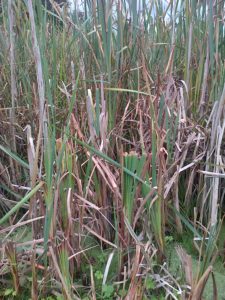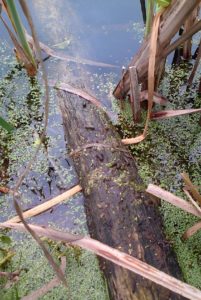With the migrant and year-round resident bird species having finished breeding at Thames Road Wetland, attention is turning once again to winter vegetation management, principally thinning out Reedmace, and now cutting some of the stands of Common Reed as well.
Thames21’s Assistant River Cray Project Officer Joanna Barton forgot one of the ‘rules’ of health and safety for this task, and stood in the firing line between a volunteer pulling out Reedmace, which tends to come with some root and a ball of wet black mud on the end, and the mounting pile on the bank it was being flung towards – with a rather amusing result.
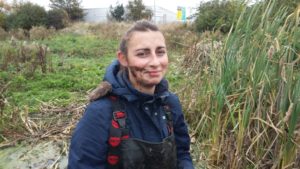
Joanna Barton wonders whether TRW mud is good for the complexion, whether any money could be made out of it, and how many showers it will take to get rid of the somewhat sulphurous smell. (Photo: Ray Hudson)
A sizeable area was cleared over a couple of hours on October 19th by just three of us, leaving smaller plants such as Rushes and Purple Loosestrife. A Water Vole feeding station was found in the process, and was skirted around. A couple of Willow saplings starting to establish themselves in the shallow margins were cut down as low as possible to prevent the beginnings of succession to wet woodland.
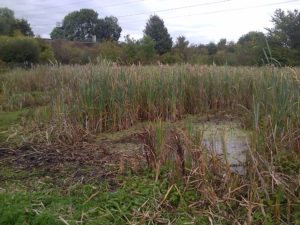
Part of the cleared area. There will still be quite a lot of submerged rhizome left, which will send up new shoots, and re-growth can be further slowed by cutting these down in spring. (Photo: Chris Rose)
This work has a number of purposes, including:
– Reducing siltation from the accumulation of dead Reedmace material.
– Favouring Rushes which Water Voles prefer to eat over Reedmace.
– Providing patches of shallow open water for Odonata, frogs and newts and improve habitat heterogeneity (the range of micro-habitats).
– Making it more attractive for horses to go further into the Reedmace which they will eat in winter, providing additional control.
Removed material is stacked for Grass Snake egg laying and utilisation by an array of decomposer species. Reedmace is quick to rot down to a peaty material so the size of the pile will diminish quite fast.
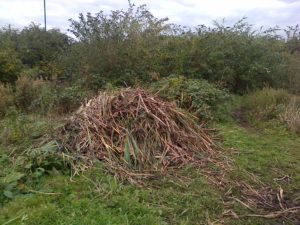
Reedmace piles at Thames Road Wetland are used by a variety of species such as Snakes, Woodlice, Spiders and no doubt various fungi. (Photo: Chris Rose)
On what was an overcast day there was little obvious wildlife action. The most dramatic event was a low-circling Sparrowhawk being mobbed by a gang of Magpies. A Cetti’s Warbler was in residence, with two more along the Cray opposite By-way 105. A couple of Jackdaw flew over and a party of Long-tailed Tits was busy foraging. A Robin in a more scrubby area was behaving just like a garden individual and coming quite close as I re-opened up a section of path to provide access for some Willow pollarding work.
More help with habitat management work at the site over the winter will be very welcome. If you are interested in getting involved please contact Joanna Barton at <joanna.barton@thames21.org.uk> There is some work to be done that doesn’t involve going in the water for anyone who doesn’t fancy getting kitted out in waders.
Chris Rose, Site Manager.

